Detailed Marketing Plan Report: TESCO's Crowdfunded Product Analysis
VerifiedAdded on 2020/01/28
|16
|4414
|651
Report
AI Summary
This report provides a comprehensive marketing plan analysis for TESCO, focusing on a new crowdfunded product. It begins with an executive summary and an introduction to marketing concepts. The core of the report is a detailed situation analysis, including micro and macro environmental factors, with a PESTEL analysis. Problems deduced from the situation analysis are discussed, along with proposed marketing objectives. The report also covers customer segmentation strategies and marketing mix tactics. The analysis aims to provide a strategic framework for launching the product successfully. The report also includes a conclusion and references, offering a well-structured approach to marketing plan development. The report also addresses challenges in satisfying customer needs and adapting to government policies. The marketing objectives are aligned with the SMART criteria, and the report emphasizes the importance of customer segmentation, providing insights into how TESCO can effectively target its audience. The report emphasizes on strategies for the company to differentiate its products from competitors.
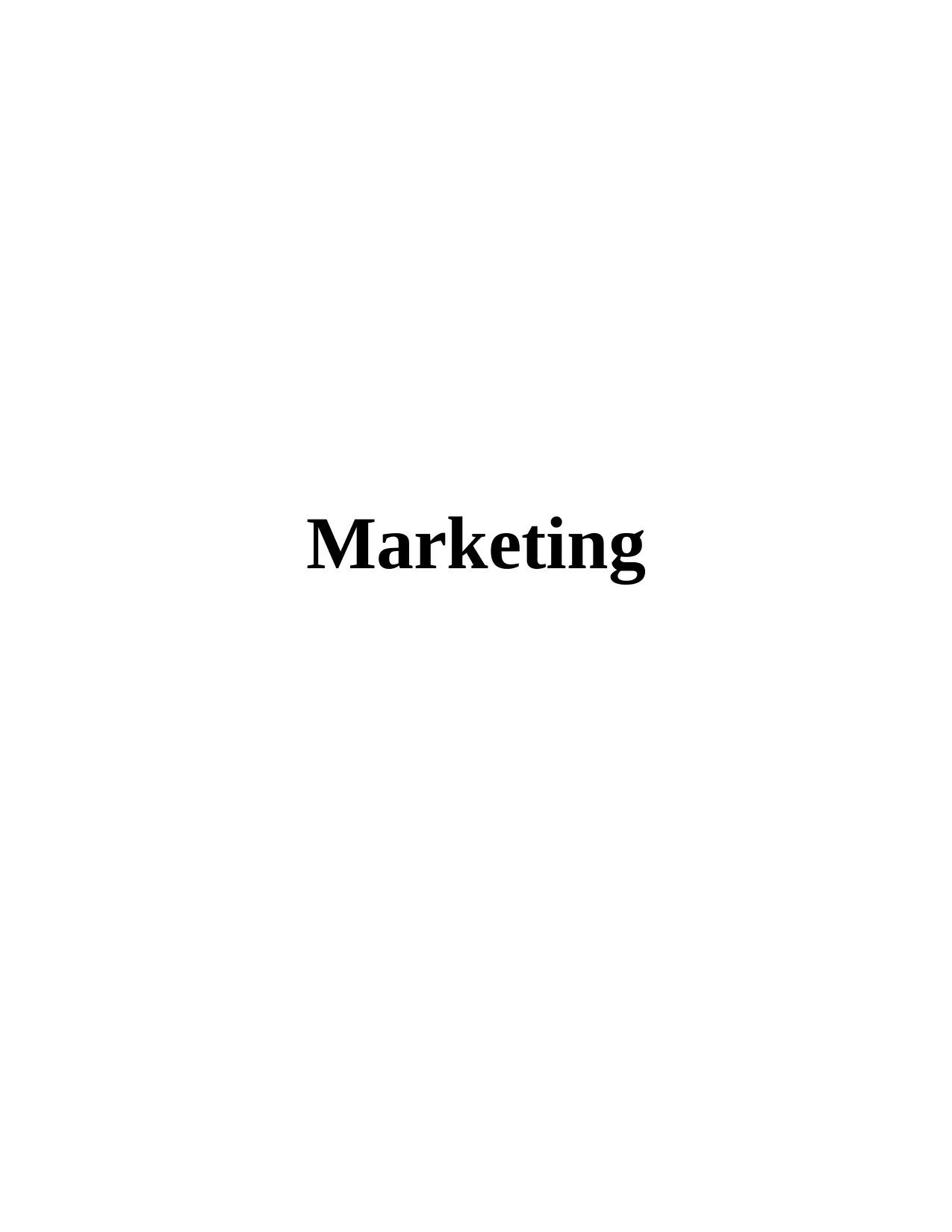
Marketing
Secure Best Marks with AI Grader
Need help grading? Try our AI Grader for instant feedback on your assignments.
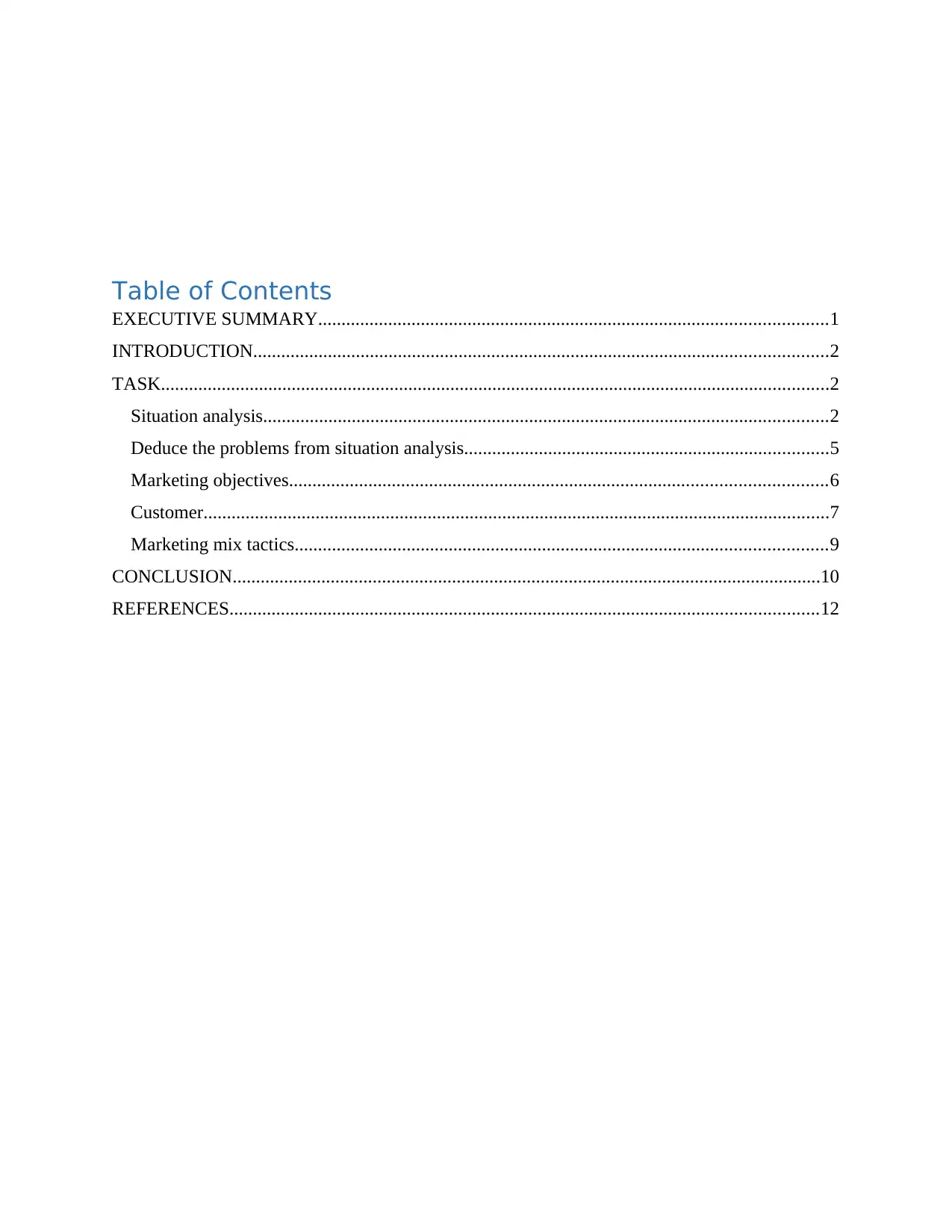
Table of Contents
EXECUTIVE SUMMARY.............................................................................................................1
INTRODUCTION...........................................................................................................................2
TASK...............................................................................................................................................2
Situation analysis.........................................................................................................................2
Deduce the problems from situation analysis..............................................................................5
Marketing objectives...................................................................................................................6
Customer......................................................................................................................................7
Marketing mix tactics..................................................................................................................9
CONCLUSION..............................................................................................................................10
REFERENCES..............................................................................................................................12
EXECUTIVE SUMMARY.............................................................................................................1
INTRODUCTION...........................................................................................................................2
TASK...............................................................................................................................................2
Situation analysis.........................................................................................................................2
Deduce the problems from situation analysis..............................................................................5
Marketing objectives...................................................................................................................6
Customer......................................................................................................................................7
Marketing mix tactics..................................................................................................................9
CONCLUSION..............................................................................................................................10
REFERENCES..............................................................................................................................12
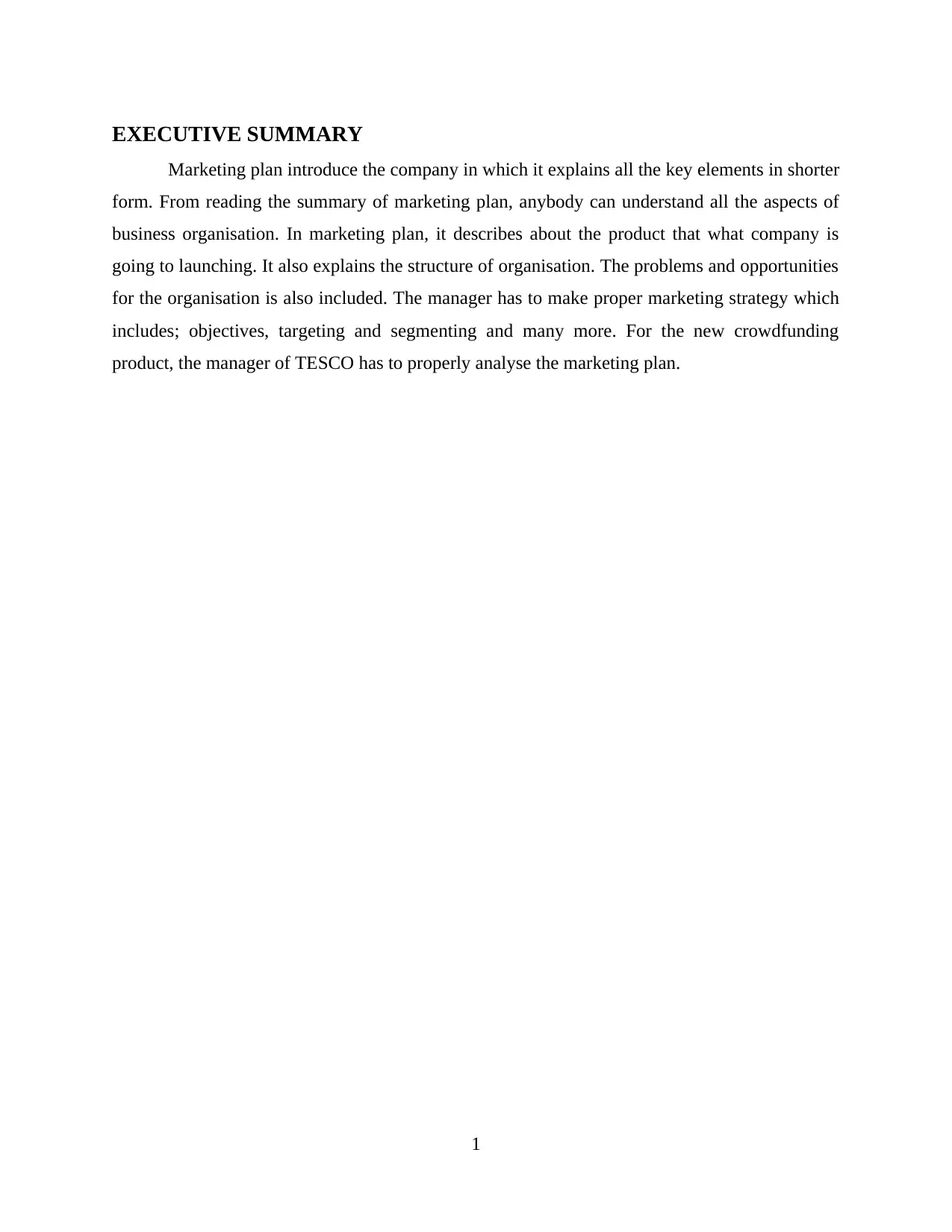
EXECUTIVE SUMMARY
Marketing plan introduce the company in which it explains all the key elements in shorter
form. From reading the summary of marketing plan, anybody can understand all the aspects of
business organisation. In marketing plan, it describes about the product that what company is
going to launching. It also explains the structure of organisation. The problems and opportunities
for the organisation is also included. The manager has to make proper marketing strategy which
includes; objectives, targeting and segmenting and many more. For the new crowdfunding
product, the manager of TESCO has to properly analyse the marketing plan.
1
Marketing plan introduce the company in which it explains all the key elements in shorter
form. From reading the summary of marketing plan, anybody can understand all the aspects of
business organisation. In marketing plan, it describes about the product that what company is
going to launching. It also explains the structure of organisation. The problems and opportunities
for the organisation is also included. The manager has to make proper marketing strategy which
includes; objectives, targeting and segmenting and many more. For the new crowdfunding
product, the manager of TESCO has to properly analyse the marketing plan.
1
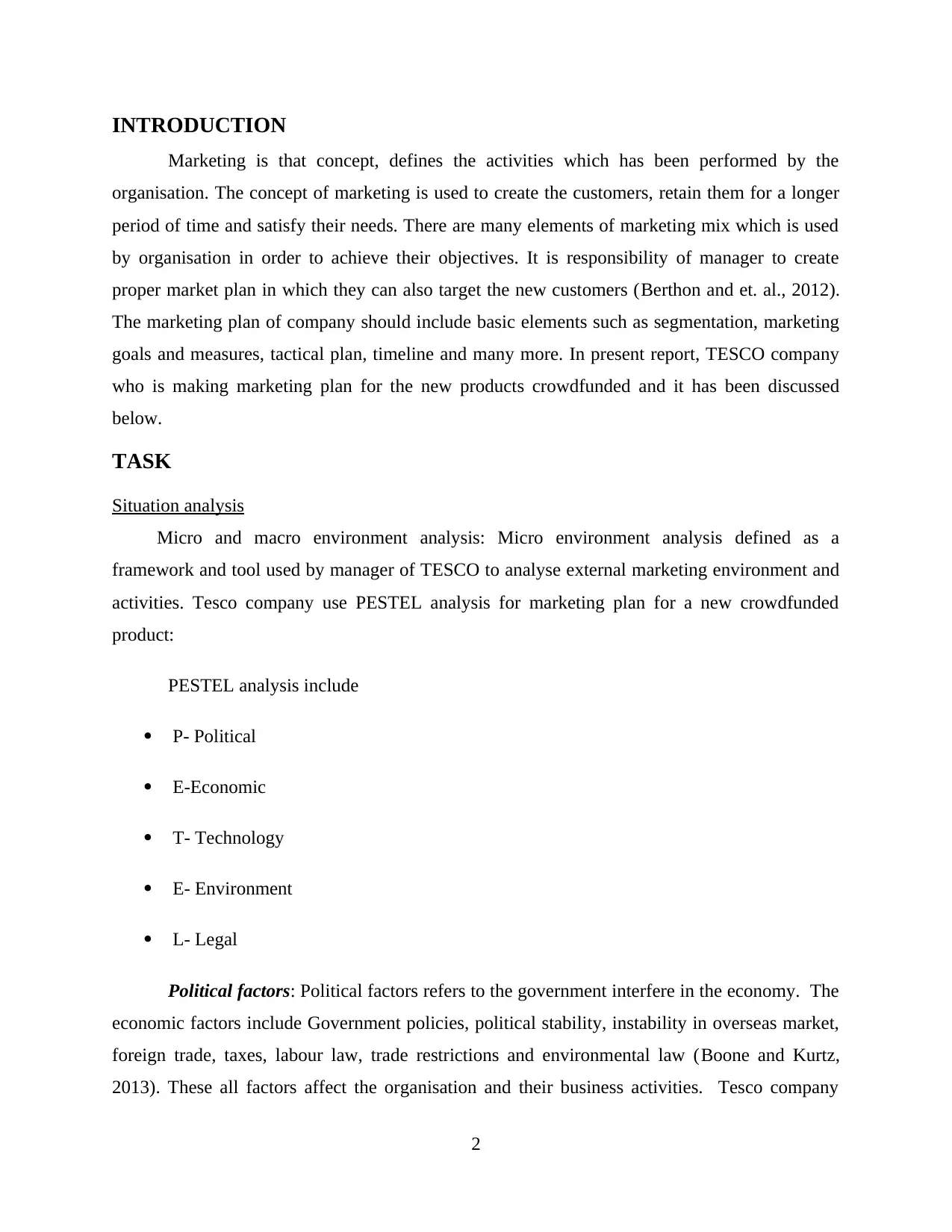
INTRODUCTION
Marketing is that concept, defines the activities which has been performed by the
organisation. The concept of marketing is used to create the customers, retain them for a longer
period of time and satisfy their needs. There are many elements of marketing mix which is used
by organisation in order to achieve their objectives. It is responsibility of manager to create
proper market plan in which they can also target the new customers (Berthon and et. al., 2012).
The marketing plan of company should include basic elements such as segmentation, marketing
goals and measures, tactical plan, timeline and many more. In present report, TESCO company
who is making marketing plan for the new products crowdfunded and it has been discussed
below.
TASK
Situation analysis
Micro and macro environment analysis: Micro environment analysis defined as a
framework and tool used by manager of TESCO to analyse external marketing environment and
activities. Tesco company use PESTEL analysis for marketing plan for a new crowdfunded
product:
PESTEL analysis include
P- Political
E-Economic
T- Technology
E- Environment
L- Legal
Political factors: Political factors refers to the government interfere in the economy. The
economic factors include Government policies, political stability, instability in overseas market,
foreign trade, taxes, labour law, trade restrictions and environmental law (Boone and Kurtz,
2013). These all factors affect the organisation and their business activities. Tesco company
2
Marketing is that concept, defines the activities which has been performed by the
organisation. The concept of marketing is used to create the customers, retain them for a longer
period of time and satisfy their needs. There are many elements of marketing mix which is used
by organisation in order to achieve their objectives. It is responsibility of manager to create
proper market plan in which they can also target the new customers (Berthon and et. al., 2012).
The marketing plan of company should include basic elements such as segmentation, marketing
goals and measures, tactical plan, timeline and many more. In present report, TESCO company
who is making marketing plan for the new products crowdfunded and it has been discussed
below.
TASK
Situation analysis
Micro and macro environment analysis: Micro environment analysis defined as a
framework and tool used by manager of TESCO to analyse external marketing environment and
activities. Tesco company use PESTEL analysis for marketing plan for a new crowdfunded
product:
PESTEL analysis include
P- Political
E-Economic
T- Technology
E- Environment
L- Legal
Political factors: Political factors refers to the government interfere in the economy. The
economic factors include Government policies, political stability, instability in overseas market,
foreign trade, taxes, labour law, trade restrictions and environmental law (Boone and Kurtz,
2013). These all factors affect the organisation and their business activities. Tesco company
2
Secure Best Marks with AI Grader
Need help grading? Try our AI Grader for instant feedback on your assignments.
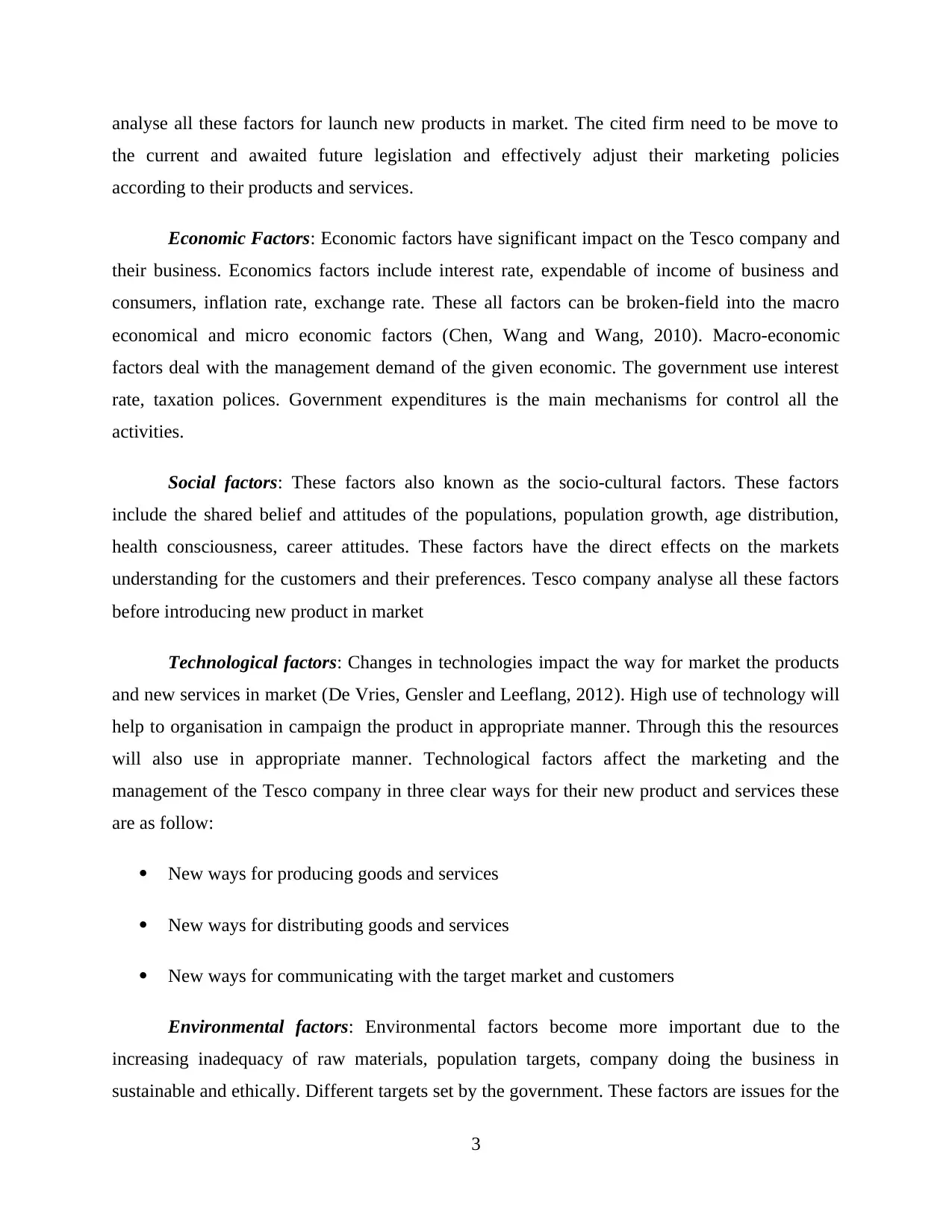
analyse all these factors for launch new products in market. The cited firm need to be move to
the current and awaited future legislation and effectively adjust their marketing policies
according to their products and services.
Economic Factors: Economic factors have significant impact on the Tesco company and
their business. Economics factors include interest rate, expendable of income of business and
consumers, inflation rate, exchange rate. These all factors can be broken-field into the macro
economical and micro economic factors (Chen, Wang and Wang, 2010). Macro-economic
factors deal with the management demand of the given economic. The government use interest
rate, taxation polices. Government expenditures is the main mechanisms for control all the
activities.
Social factors: These factors also known as the socio-cultural factors. These factors
include the shared belief and attitudes of the populations, population growth, age distribution,
health consciousness, career attitudes. These factors have the direct effects on the markets
understanding for the customers and their preferences. Tesco company analyse all these factors
before introducing new product in market
Technological factors: Changes in technologies impact the way for market the products
and new services in market (De Vries, Gensler and Leeflang, 2012). High use of technology will
help to organisation in campaign the product in appropriate manner. Through this the resources
will also use in appropriate manner. Technological factors affect the marketing and the
management of the Tesco company in three clear ways for their new product and services these
are as follow:
New ways for producing goods and services
New ways for distributing goods and services
New ways for communicating with the target market and customers
Environmental factors: Environmental factors become more important due to the
increasing inadequacy of raw materials, population targets, company doing the business in
sustainable and ethically. Different targets set by the government. These factors are issues for the
3
the current and awaited future legislation and effectively adjust their marketing policies
according to their products and services.
Economic Factors: Economic factors have significant impact on the Tesco company and
their business. Economics factors include interest rate, expendable of income of business and
consumers, inflation rate, exchange rate. These all factors can be broken-field into the macro
economical and micro economic factors (Chen, Wang and Wang, 2010). Macro-economic
factors deal with the management demand of the given economic. The government use interest
rate, taxation polices. Government expenditures is the main mechanisms for control all the
activities.
Social factors: These factors also known as the socio-cultural factors. These factors
include the shared belief and attitudes of the populations, population growth, age distribution,
health consciousness, career attitudes. These factors have the direct effects on the markets
understanding for the customers and their preferences. Tesco company analyse all these factors
before introducing new product in market
Technological factors: Changes in technologies impact the way for market the products
and new services in market (De Vries, Gensler and Leeflang, 2012). High use of technology will
help to organisation in campaign the product in appropriate manner. Through this the resources
will also use in appropriate manner. Technological factors affect the marketing and the
management of the Tesco company in three clear ways for their new product and services these
are as follow:
New ways for producing goods and services
New ways for distributing goods and services
New ways for communicating with the target market and customers
Environmental factors: Environmental factors become more important due to the
increasing inadequacy of raw materials, population targets, company doing the business in
sustainable and ethically. Different targets set by the government. These factors are issues for the
3
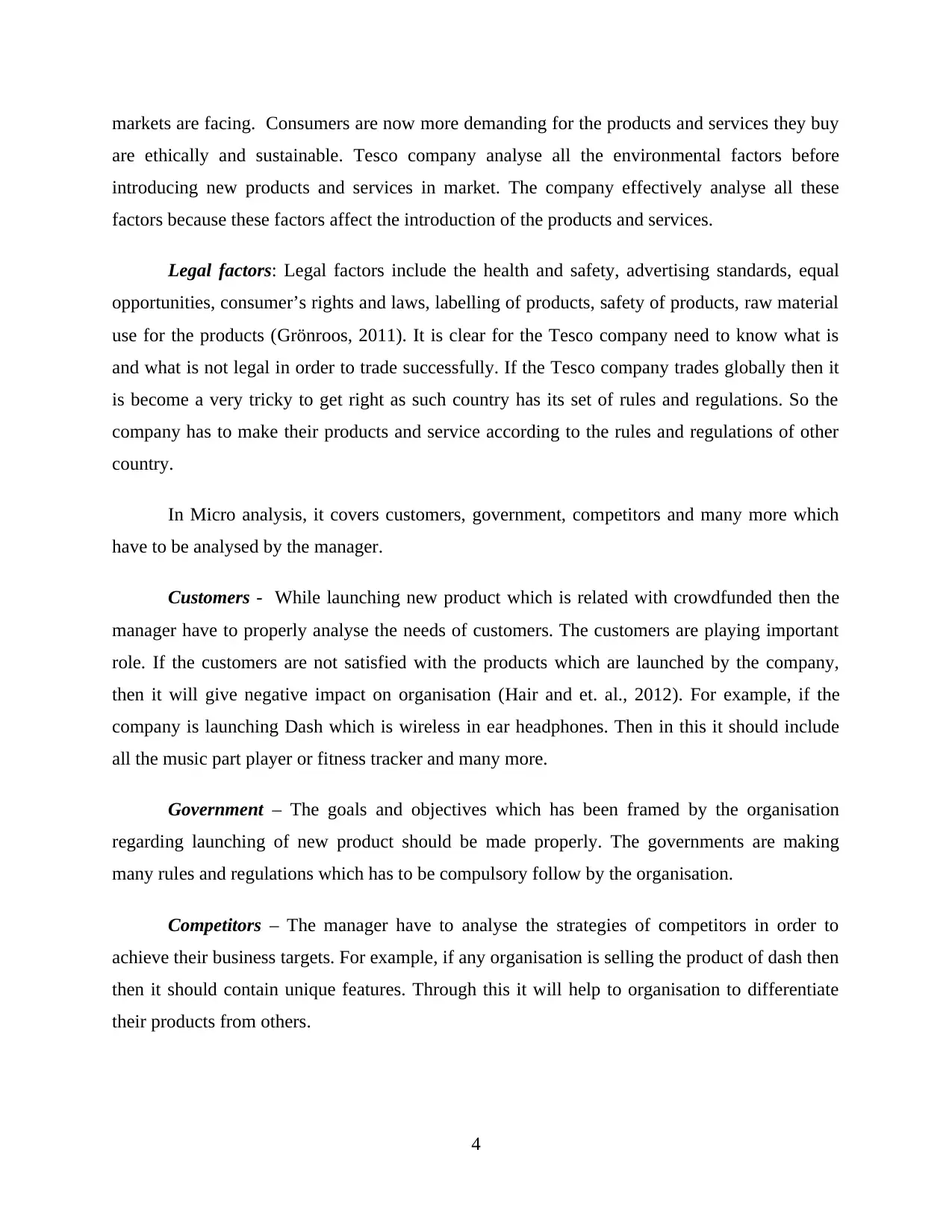
markets are facing. Consumers are now more demanding for the products and services they buy
are ethically and sustainable. Tesco company analyse all the environmental factors before
introducing new products and services in market. The company effectively analyse all these
factors because these factors affect the introduction of the products and services.
Legal factors: Legal factors include the health and safety, advertising standards, equal
opportunities, consumer’s rights and laws, labelling of products, safety of products, raw material
use for the products (Grönroos, 2011). It is clear for the Tesco company need to know what is
and what is not legal in order to trade successfully. If the Tesco company trades globally then it
is become a very tricky to get right as such country has its set of rules and regulations. So the
company has to make their products and service according to the rules and regulations of other
country.
In Micro analysis, it covers customers, government, competitors and many more which
have to be analysed by the manager.
Customers - While launching new product which is related with crowdfunded then the
manager have to properly analyse the needs of customers. The customers are playing important
role. If the customers are not satisfied with the products which are launched by the company,
then it will give negative impact on organisation (Hair and et. al., 2012). For example, if the
company is launching Dash which is wireless in ear headphones. Then in this it should include
all the music part player or fitness tracker and many more.
Government – The goals and objectives which has been framed by the organisation
regarding launching of new product should be made properly. The governments are making
many rules and regulations which has to be compulsory follow by the organisation.
Competitors – The manager have to analyse the strategies of competitors in order to
achieve their business targets. For example, if any organisation is selling the product of dash then
then it should contain unique features. Through this it will help to organisation to differentiate
their products from others.
4
are ethically and sustainable. Tesco company analyse all the environmental factors before
introducing new products and services in market. The company effectively analyse all these
factors because these factors affect the introduction of the products and services.
Legal factors: Legal factors include the health and safety, advertising standards, equal
opportunities, consumer’s rights and laws, labelling of products, safety of products, raw material
use for the products (Grönroos, 2011). It is clear for the Tesco company need to know what is
and what is not legal in order to trade successfully. If the Tesco company trades globally then it
is become a very tricky to get right as such country has its set of rules and regulations. So the
company has to make their products and service according to the rules and regulations of other
country.
In Micro analysis, it covers customers, government, competitors and many more which
have to be analysed by the manager.
Customers - While launching new product which is related with crowdfunded then the
manager have to properly analyse the needs of customers. The customers are playing important
role. If the customers are not satisfied with the products which are launched by the company,
then it will give negative impact on organisation (Hair and et. al., 2012). For example, if the
company is launching Dash which is wireless in ear headphones. Then in this it should include
all the music part player or fitness tracker and many more.
Government – The goals and objectives which has been framed by the organisation
regarding launching of new product should be made properly. The governments are making
many rules and regulations which has to be compulsory follow by the organisation.
Competitors – The manager have to analyse the strategies of competitors in order to
achieve their business targets. For example, if any organisation is selling the product of dash then
then it should contain unique features. Through this it will help to organisation to differentiate
their products from others.
4
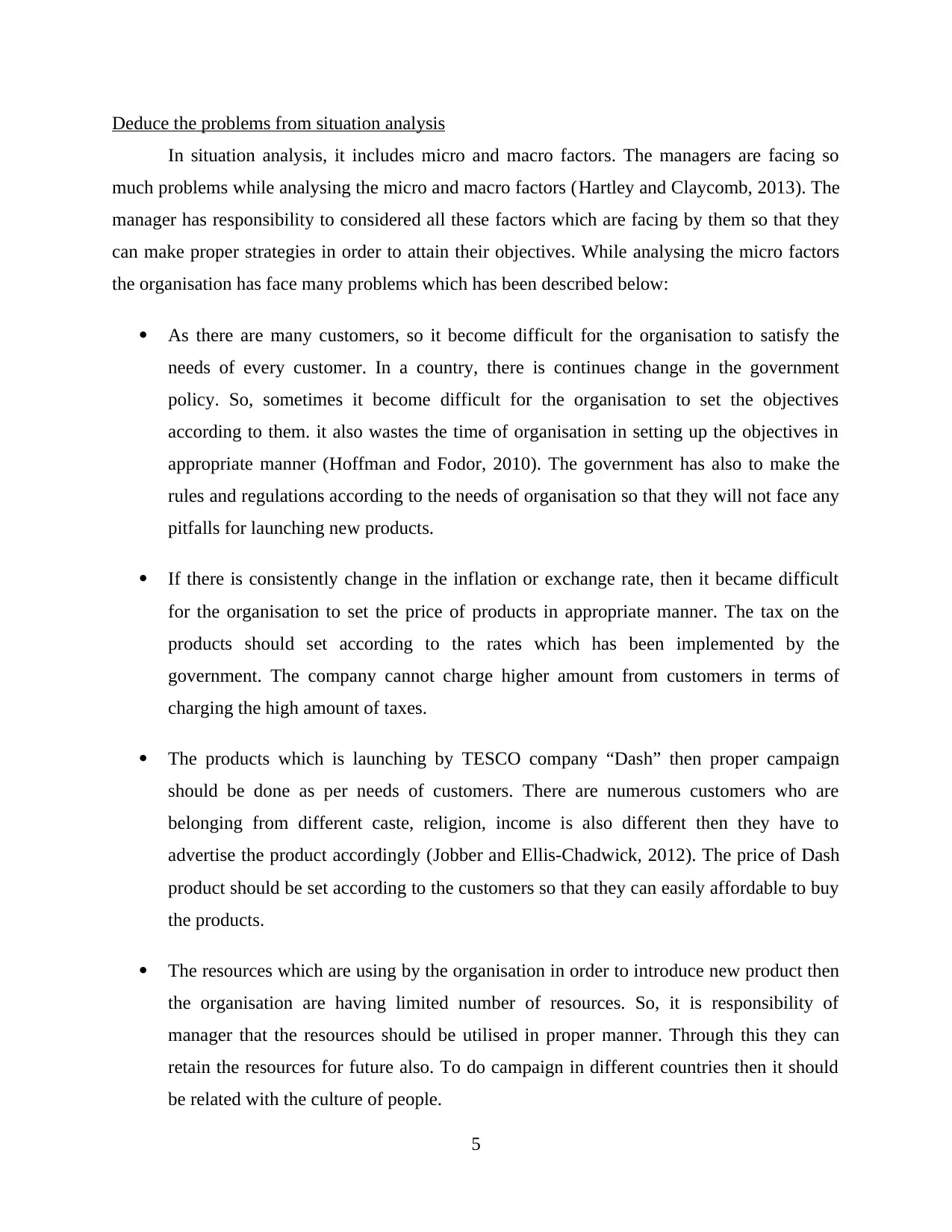
Deduce the problems from situation analysis
In situation analysis, it includes micro and macro factors. The managers are facing so
much problems while analysing the micro and macro factors (Hartley and Claycomb, 2013). The
manager has responsibility to considered all these factors which are facing by them so that they
can make proper strategies in order to attain their objectives. While analysing the micro factors
the organisation has face many problems which has been described below:
As there are many customers, so it become difficult for the organisation to satisfy the
needs of every customer. In a country, there is continues change in the government
policy. So, sometimes it become difficult for the organisation to set the objectives
according to them. it also wastes the time of organisation in setting up the objectives in
appropriate manner (Hoffman and Fodor, 2010). The government has also to make the
rules and regulations according to the needs of organisation so that they will not face any
pitfalls for launching new products.
If there is consistently change in the inflation or exchange rate, then it became difficult
for the organisation to set the price of products in appropriate manner. The tax on the
products should set according to the rates which has been implemented by the
government. The company cannot charge higher amount from customers in terms of
charging the high amount of taxes.
The products which is launching by TESCO company “Dash” then proper campaign
should be done as per needs of customers. There are numerous customers who are
belonging from different caste, religion, income is also different then they have to
advertise the product accordingly (Jobber and Ellis-Chadwick, 2012). The price of Dash
product should be set according to the customers so that they can easily affordable to buy
the products.
The resources which are using by the organisation in order to introduce new product then
the organisation are having limited number of resources. So, it is responsibility of
manager that the resources should be utilised in proper manner. Through this they can
retain the resources for future also. To do campaign in different countries then it should
be related with the culture of people.
5
In situation analysis, it includes micro and macro factors. The managers are facing so
much problems while analysing the micro and macro factors (Hartley and Claycomb, 2013). The
manager has responsibility to considered all these factors which are facing by them so that they
can make proper strategies in order to attain their objectives. While analysing the micro factors
the organisation has face many problems which has been described below:
As there are many customers, so it become difficult for the organisation to satisfy the
needs of every customer. In a country, there is continues change in the government
policy. So, sometimes it become difficult for the organisation to set the objectives
according to them. it also wastes the time of organisation in setting up the objectives in
appropriate manner (Hoffman and Fodor, 2010). The government has also to make the
rules and regulations according to the needs of organisation so that they will not face any
pitfalls for launching new products.
If there is consistently change in the inflation or exchange rate, then it became difficult
for the organisation to set the price of products in appropriate manner. The tax on the
products should set according to the rates which has been implemented by the
government. The company cannot charge higher amount from customers in terms of
charging the high amount of taxes.
The products which is launching by TESCO company “Dash” then proper campaign
should be done as per needs of customers. There are numerous customers who are
belonging from different caste, religion, income is also different then they have to
advertise the product accordingly (Jobber and Ellis-Chadwick, 2012). The price of Dash
product should be set according to the customers so that they can easily affordable to buy
the products.
The resources which are using by the organisation in order to introduce new product then
the organisation are having limited number of resources. So, it is responsibility of
manager that the resources should be utilised in proper manner. Through this they can
retain the resources for future also. To do campaign in different countries then it should
be related with the culture of people.
5
Paraphrase This Document
Need a fresh take? Get an instant paraphrase of this document with our AI Paraphraser
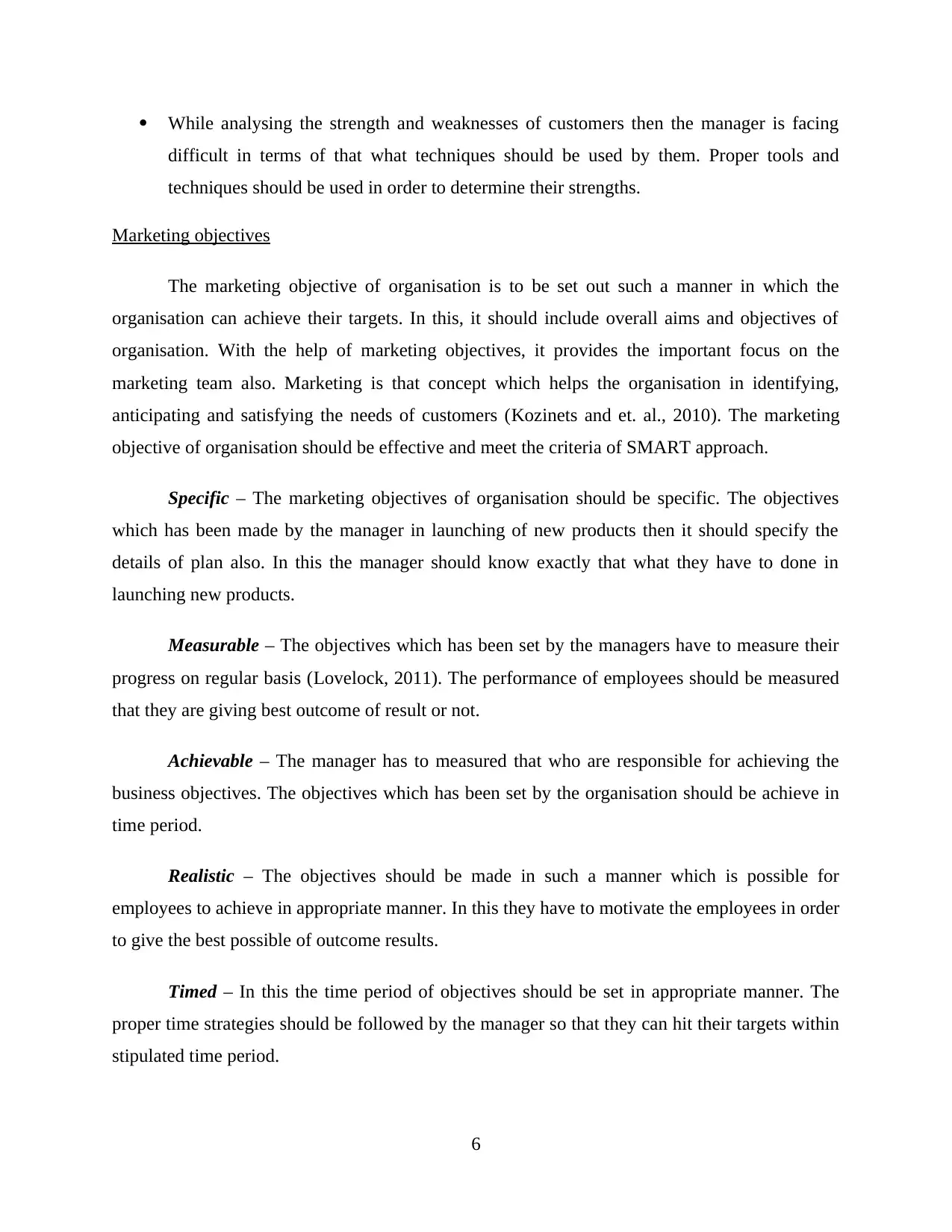
While analysing the strength and weaknesses of customers then the manager is facing
difficult in terms of that what techniques should be used by them. Proper tools and
techniques should be used in order to determine their strengths.
Marketing objectives
The marketing objective of organisation is to be set out such a manner in which the
organisation can achieve their targets. In this, it should include overall aims and objectives of
organisation. With the help of marketing objectives, it provides the important focus on the
marketing team also. Marketing is that concept which helps the organisation in identifying,
anticipating and satisfying the needs of customers (Kozinets and et. al., 2010). The marketing
objective of organisation should be effective and meet the criteria of SMART approach.
Specific – The marketing objectives of organisation should be specific. The objectives
which has been made by the manager in launching of new products then it should specify the
details of plan also. In this the manager should know exactly that what they have to done in
launching new products.
Measurable – The objectives which has been set by the managers have to measure their
progress on regular basis (Lovelock, 2011). The performance of employees should be measured
that they are giving best outcome of result or not.
Achievable – The manager has to measured that who are responsible for achieving the
business objectives. The objectives which has been set by the organisation should be achieve in
time period.
Realistic – The objectives should be made in such a manner which is possible for
employees to achieve in appropriate manner. In this they have to motivate the employees in order
to give the best possible of outcome results.
Timed – In this the time period of objectives should be set in appropriate manner. The
proper time strategies should be followed by the manager so that they can hit their targets within
stipulated time period.
6
difficult in terms of that what techniques should be used by them. Proper tools and
techniques should be used in order to determine their strengths.
Marketing objectives
The marketing objective of organisation is to be set out such a manner in which the
organisation can achieve their targets. In this, it should include overall aims and objectives of
organisation. With the help of marketing objectives, it provides the important focus on the
marketing team also. Marketing is that concept which helps the organisation in identifying,
anticipating and satisfying the needs of customers (Kozinets and et. al., 2010). The marketing
objective of organisation should be effective and meet the criteria of SMART approach.
Specific – The marketing objectives of organisation should be specific. The objectives
which has been made by the manager in launching of new products then it should specify the
details of plan also. In this the manager should know exactly that what they have to done in
launching new products.
Measurable – The objectives which has been set by the managers have to measure their
progress on regular basis (Lovelock, 2011). The performance of employees should be measured
that they are giving best outcome of result or not.
Achievable – The manager has to measured that who are responsible for achieving the
business objectives. The objectives which has been set by the organisation should be achieve in
time period.
Realistic – The objectives should be made in such a manner which is possible for
employees to achieve in appropriate manner. In this they have to motivate the employees in order
to give the best possible of outcome results.
Timed – In this the time period of objectives should be set in appropriate manner. The
proper time strategies should be followed by the manager so that they can hit their targets within
stipulated time period.
6
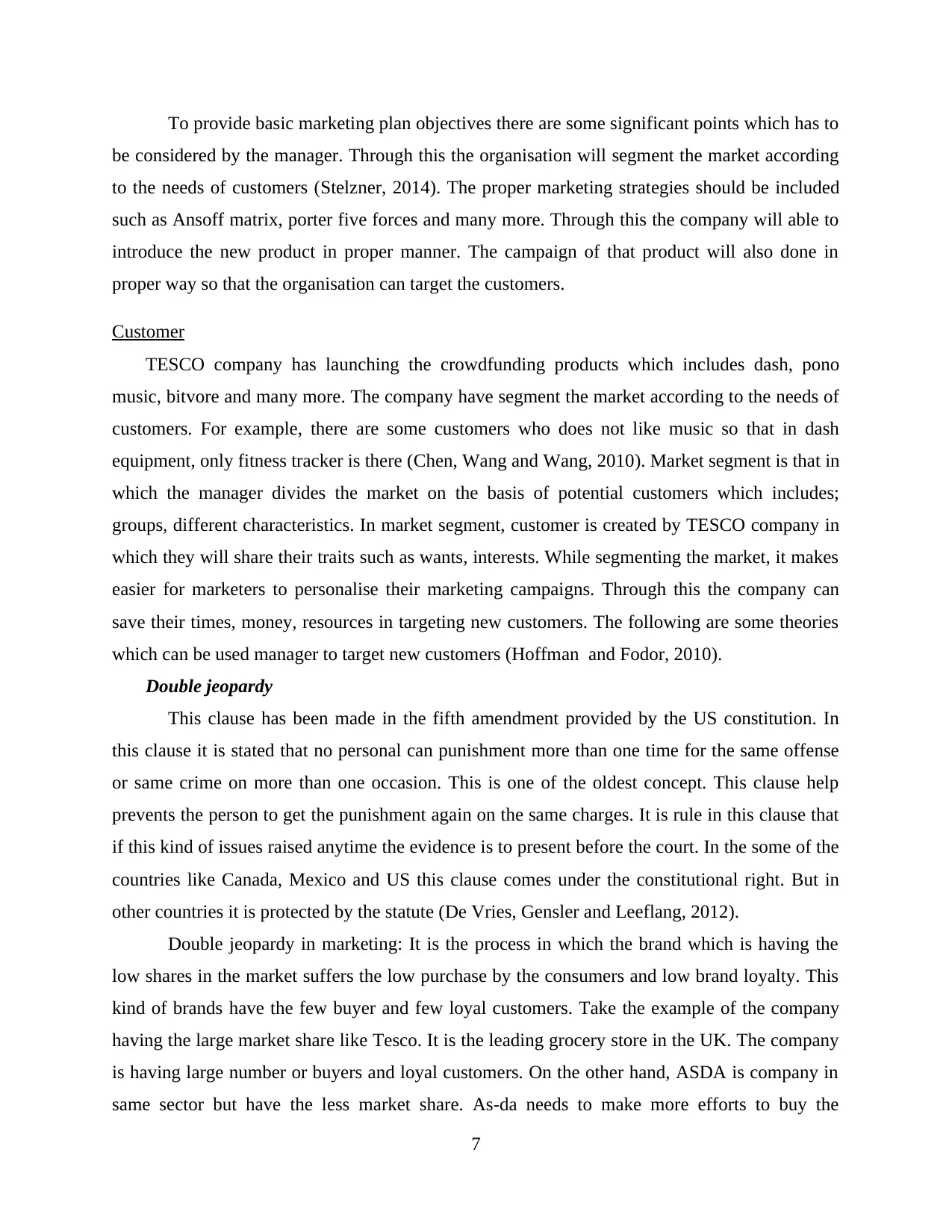
To provide basic marketing plan objectives there are some significant points which has to
be considered by the manager. Through this the organisation will segment the market according
to the needs of customers (Stelzner, 2014). The proper marketing strategies should be included
such as Ansoff matrix, porter five forces and many more. Through this the company will able to
introduce the new product in proper manner. The campaign of that product will also done in
proper way so that the organisation can target the customers.
Customer
TESCO company has launching the crowdfunding products which includes dash, pono
music, bitvore and many more. The company have segment the market according to the needs of
customers. For example, there are some customers who does not like music so that in dash
equipment, only fitness tracker is there (Chen, Wang and Wang, 2010). Market segment is that in
which the manager divides the market on the basis of potential customers which includes;
groups, different characteristics. In market segment, customer is created by TESCO company in
which they will share their traits such as wants, interests. While segmenting the market, it makes
easier for marketers to personalise their marketing campaigns. Through this the company can
save their times, money, resources in targeting new customers. The following are some theories
which can be used manager to target new customers (Hoffman and Fodor, 2010).
Double jeopardy
This clause has been made in the fifth amendment provided by the US constitution. In
this clause it is stated that no personal can punishment more than one time for the same offense
or same crime on more than one occasion. This is one of the oldest concept. This clause help
prevents the person to get the punishment again on the same charges. It is rule in this clause that
if this kind of issues raised anytime the evidence is to present before the court. In the some of the
countries like Canada, Mexico and US this clause comes under the constitutional right. But in
other countries it is protected by the statute (De Vries, Gensler and Leeflang, 2012).
Double jeopardy in marketing: It is the process in which the brand which is having the
low shares in the market suffers the low purchase by the consumers and low brand loyalty. This
kind of brands have the few buyer and few loyal customers. Take the example of the company
having the large market share like Tesco. It is the leading grocery store in the UK. The company
is having large number or buyers and loyal customers. On the other hand, ASDA is company in
same sector but have the less market share. As-da needs to make more efforts to buy the
7
be considered by the manager. Through this the organisation will segment the market according
to the needs of customers (Stelzner, 2014). The proper marketing strategies should be included
such as Ansoff matrix, porter five forces and many more. Through this the company will able to
introduce the new product in proper manner. The campaign of that product will also done in
proper way so that the organisation can target the customers.
Customer
TESCO company has launching the crowdfunding products which includes dash, pono
music, bitvore and many more. The company have segment the market according to the needs of
customers. For example, there are some customers who does not like music so that in dash
equipment, only fitness tracker is there (Chen, Wang and Wang, 2010). Market segment is that in
which the manager divides the market on the basis of potential customers which includes;
groups, different characteristics. In market segment, customer is created by TESCO company in
which they will share their traits such as wants, interests. While segmenting the market, it makes
easier for marketers to personalise their marketing campaigns. Through this the company can
save their times, money, resources in targeting new customers. The following are some theories
which can be used manager to target new customers (Hoffman and Fodor, 2010).
Double jeopardy
This clause has been made in the fifth amendment provided by the US constitution. In
this clause it is stated that no personal can punishment more than one time for the same offense
or same crime on more than one occasion. This is one of the oldest concept. This clause help
prevents the person to get the punishment again on the same charges. It is rule in this clause that
if this kind of issues raised anytime the evidence is to present before the court. In the some of the
countries like Canada, Mexico and US this clause comes under the constitutional right. But in
other countries it is protected by the statute (De Vries, Gensler and Leeflang, 2012).
Double jeopardy in marketing: It is the process in which the brand which is having the
low shares in the market suffers the low purchase by the consumers and low brand loyalty. This
kind of brands have the few buyer and few loyal customers. Take the example of the company
having the large market share like Tesco. It is the leading grocery store in the UK. The company
is having large number or buyers and loyal customers. On the other hand, ASDA is company in
same sector but have the less market share. As-da needs to make more efforts to buy the
7
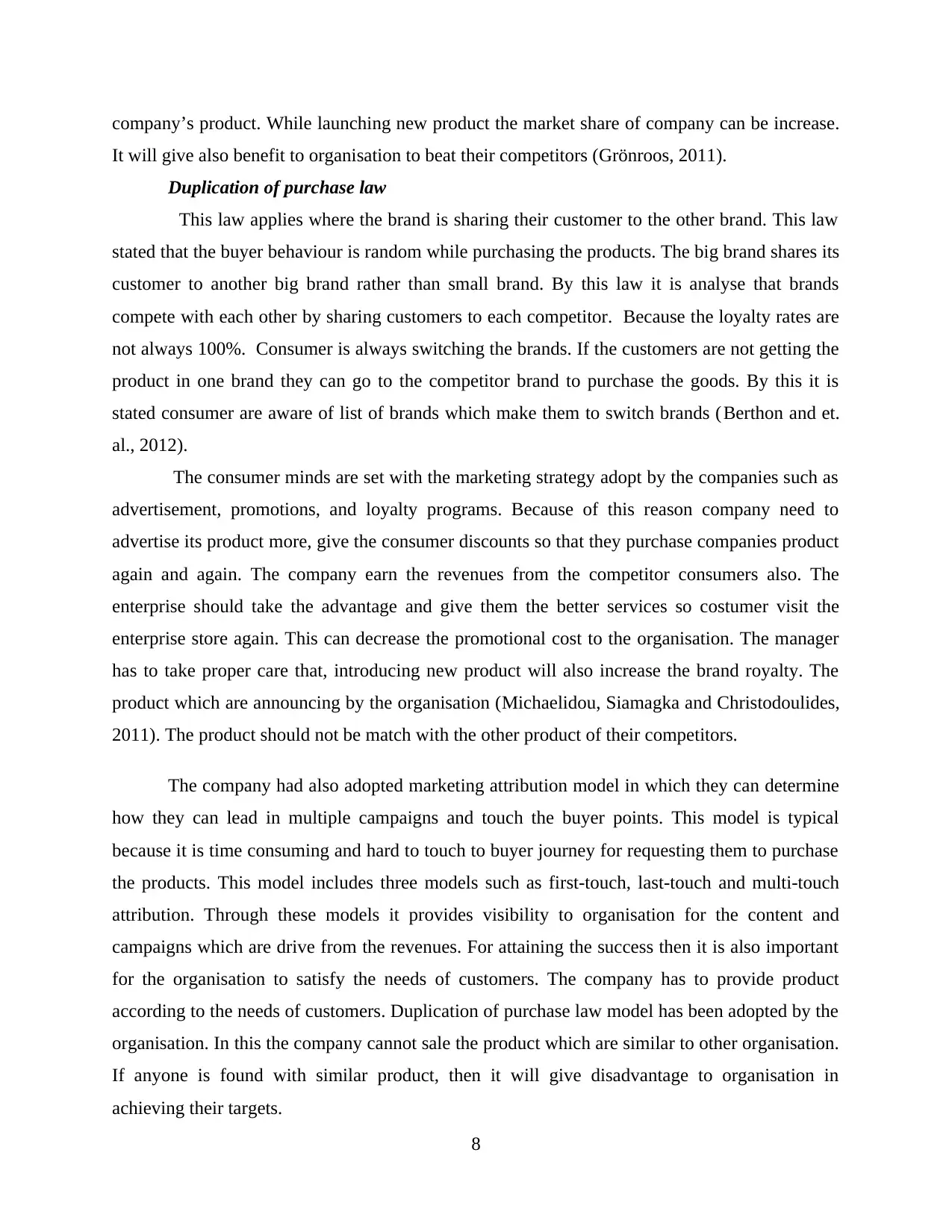
company’s product. While launching new product the market share of company can be increase.
It will give also benefit to organisation to beat their competitors (Grönroos, 2011).
Duplication of purchase law
This law applies where the brand is sharing their customer to the other brand. This law
stated that the buyer behaviour is random while purchasing the products. The big brand shares its
customer to another big brand rather than small brand. By this law it is analyse that brands
compete with each other by sharing customers to each competitor. Because the loyalty rates are
not always 100%. Consumer is always switching the brands. If the customers are not getting the
product in one brand they can go to the competitor brand to purchase the goods. By this it is
stated consumer are aware of list of brands which make them to switch brands (Berthon and et.
al., 2012).
The consumer minds are set with the marketing strategy adopt by the companies such as
advertisement, promotions, and loyalty programs. Because of this reason company need to
advertise its product more, give the consumer discounts so that they purchase companies product
again and again. The company earn the revenues from the competitor consumers also. The
enterprise should take the advantage and give them the better services so costumer visit the
enterprise store again. This can decrease the promotional cost to the organisation. The manager
has to take proper care that, introducing new product will also increase the brand royalty. The
product which are announcing by the organisation (Michaelidou, Siamagka and Christodoulides,
2011). The product should not be match with the other product of their competitors.
The company had also adopted marketing attribution model in which they can determine
how they can lead in multiple campaigns and touch the buyer points. This model is typical
because it is time consuming and hard to touch to buyer journey for requesting them to purchase
the products. This model includes three models such as first-touch, last-touch and multi-touch
attribution. Through these models it provides visibility to organisation for the content and
campaigns which are drive from the revenues. For attaining the success then it is also important
for the organisation to satisfy the needs of customers. The company has to provide product
according to the needs of customers. Duplication of purchase law model has been adopted by the
organisation. In this the company cannot sale the product which are similar to other organisation.
If anyone is found with similar product, then it will give disadvantage to organisation in
achieving their targets.
8
It will give also benefit to organisation to beat their competitors (Grönroos, 2011).
Duplication of purchase law
This law applies where the brand is sharing their customer to the other brand. This law
stated that the buyer behaviour is random while purchasing the products. The big brand shares its
customer to another big brand rather than small brand. By this law it is analyse that brands
compete with each other by sharing customers to each competitor. Because the loyalty rates are
not always 100%. Consumer is always switching the brands. If the customers are not getting the
product in one brand they can go to the competitor brand to purchase the goods. By this it is
stated consumer are aware of list of brands which make them to switch brands (Berthon and et.
al., 2012).
The consumer minds are set with the marketing strategy adopt by the companies such as
advertisement, promotions, and loyalty programs. Because of this reason company need to
advertise its product more, give the consumer discounts so that they purchase companies product
again and again. The company earn the revenues from the competitor consumers also. The
enterprise should take the advantage and give them the better services so costumer visit the
enterprise store again. This can decrease the promotional cost to the organisation. The manager
has to take proper care that, introducing new product will also increase the brand royalty. The
product which are announcing by the organisation (Michaelidou, Siamagka and Christodoulides,
2011). The product should not be match with the other product of their competitors.
The company had also adopted marketing attribution model in which they can determine
how they can lead in multiple campaigns and touch the buyer points. This model is typical
because it is time consuming and hard to touch to buyer journey for requesting them to purchase
the products. This model includes three models such as first-touch, last-touch and multi-touch
attribution. Through these models it provides visibility to organisation for the content and
campaigns which are drive from the revenues. For attaining the success then it is also important
for the organisation to satisfy the needs of customers. The company has to provide product
according to the needs of customers. Duplication of purchase law model has been adopted by the
organisation. In this the company cannot sale the product which are similar to other organisation.
If anyone is found with similar product, then it will give disadvantage to organisation in
achieving their targets.
8
Secure Best Marks with AI Grader
Need help grading? Try our AI Grader for instant feedback on your assignments.
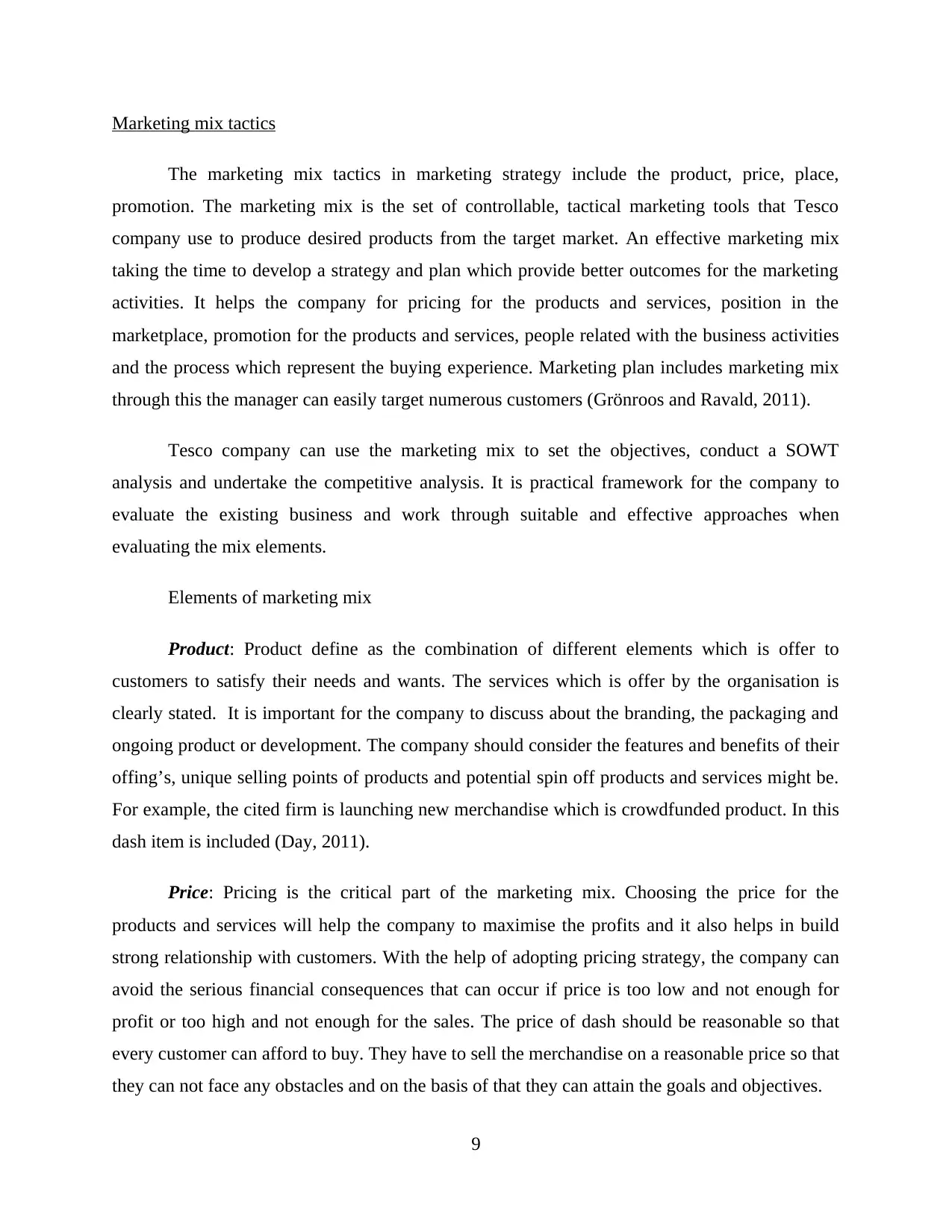
Marketing mix tactics
The marketing mix tactics in marketing strategy include the product, price, place,
promotion. The marketing mix is the set of controllable, tactical marketing tools that Tesco
company use to produce desired products from the target market. An effective marketing mix
taking the time to develop a strategy and plan which provide better outcomes for the marketing
activities. It helps the company for pricing for the products and services, position in the
marketplace, promotion for the products and services, people related with the business activities
and the process which represent the buying experience. Marketing plan includes marketing mix
through this the manager can easily target numerous customers (Grönroos and Ravald, 2011).
Tesco company can use the marketing mix to set the objectives, conduct a SOWT
analysis and undertake the competitive analysis. It is practical framework for the company to
evaluate the existing business and work through suitable and effective approaches when
evaluating the mix elements.
Elements of marketing mix
Product: Product define as the combination of different elements which is offer to
customers to satisfy their needs and wants. The services which is offer by the organisation is
clearly stated. It is important for the company to discuss about the branding, the packaging and
ongoing product or development. The company should consider the features and benefits of their
offing’s, unique selling points of products and potential spin off products and services might be.
For example, the cited firm is launching new merchandise which is crowdfunded product. In this
dash item is included (Day, 2011).
Price: Pricing is the critical part of the marketing mix. Choosing the price for the
products and services will help the company to maximise the profits and it also helps in build
strong relationship with customers. With the help of adopting pricing strategy, the company can
avoid the serious financial consequences that can occur if price is too low and not enough for
profit or too high and not enough for the sales. The price of dash should be reasonable so that
every customer can afford to buy. They have to sell the merchandise on a reasonable price so that
they can not face any obstacles and on the basis of that they can attain the goals and objectives.
9
The marketing mix tactics in marketing strategy include the product, price, place,
promotion. The marketing mix is the set of controllable, tactical marketing tools that Tesco
company use to produce desired products from the target market. An effective marketing mix
taking the time to develop a strategy and plan which provide better outcomes for the marketing
activities. It helps the company for pricing for the products and services, position in the
marketplace, promotion for the products and services, people related with the business activities
and the process which represent the buying experience. Marketing plan includes marketing mix
through this the manager can easily target numerous customers (Grönroos and Ravald, 2011).
Tesco company can use the marketing mix to set the objectives, conduct a SOWT
analysis and undertake the competitive analysis. It is practical framework for the company to
evaluate the existing business and work through suitable and effective approaches when
evaluating the mix elements.
Elements of marketing mix
Product: Product define as the combination of different elements which is offer to
customers to satisfy their needs and wants. The services which is offer by the organisation is
clearly stated. It is important for the company to discuss about the branding, the packaging and
ongoing product or development. The company should consider the features and benefits of their
offing’s, unique selling points of products and potential spin off products and services might be.
For example, the cited firm is launching new merchandise which is crowdfunded product. In this
dash item is included (Day, 2011).
Price: Pricing is the critical part of the marketing mix. Choosing the price for the
products and services will help the company to maximise the profits and it also helps in build
strong relationship with customers. With the help of adopting pricing strategy, the company can
avoid the serious financial consequences that can occur if price is too low and not enough for
profit or too high and not enough for the sales. The price of dash should be reasonable so that
every customer can afford to buy. They have to sell the merchandise on a reasonable price so that
they can not face any obstacles and on the basis of that they can attain the goals and objectives.
9
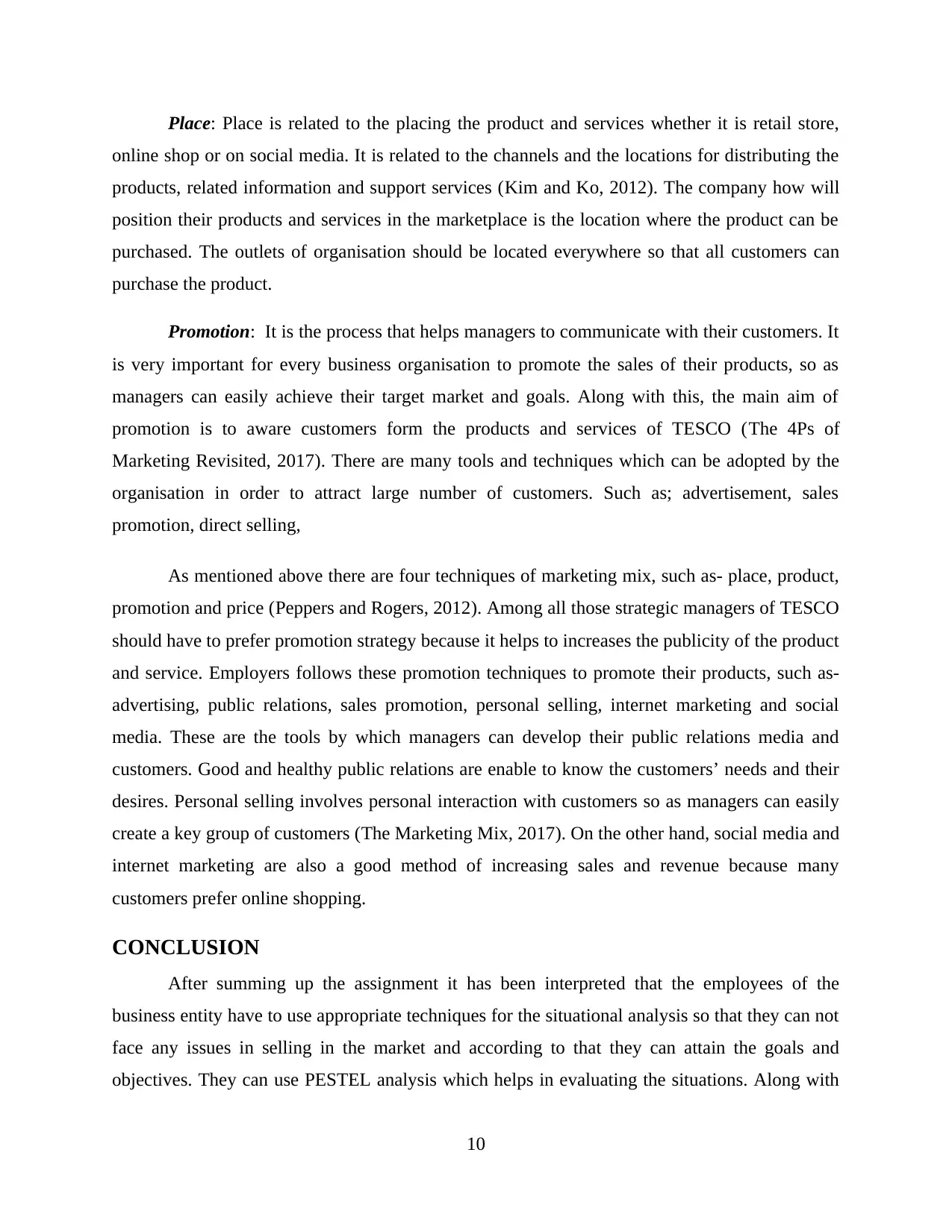
Place: Place is related to the placing the product and services whether it is retail store,
online shop or on social media. It is related to the channels and the locations for distributing the
products, related information and support services (Kim and Ko, 2012). The company how will
position their products and services in the marketplace is the location where the product can be
purchased. The outlets of organisation should be located everywhere so that all customers can
purchase the product.
Promotion: It is the process that helps managers to communicate with their customers. It
is very important for every business organisation to promote the sales of their products, so as
managers can easily achieve their target market and goals. Along with this, the main aim of
promotion is to aware customers form the products and services of TESCO (The 4Ps of
Marketing Revisited, 2017). There are many tools and techniques which can be adopted by the
organisation in order to attract large number of customers. Such as; advertisement, sales
promotion, direct selling,
As mentioned above there are four techniques of marketing mix, such as- place, product,
promotion and price (Peppers and Rogers, 2012). Among all those strategic managers of TESCO
should have to prefer promotion strategy because it helps to increases the publicity of the product
and service. Employers follows these promotion techniques to promote their products, such as-
advertising, public relations, sales promotion, personal selling, internet marketing and social
media. These are the tools by which managers can develop their public relations media and
customers. Good and healthy public relations are enable to know the customers’ needs and their
desires. Personal selling involves personal interaction with customers so as managers can easily
create a key group of customers (The Marketing Mix, 2017). On the other hand, social media and
internet marketing are also a good method of increasing sales and revenue because many
customers prefer online shopping.
CONCLUSION
After summing up the assignment it has been interpreted that the employees of the
business entity have to use appropriate techniques for the situational analysis so that they can not
face any issues in selling in the market and according to that they can attain the goals and
objectives. They can use PESTEL analysis which helps in evaluating the situations. Along with
10
online shop or on social media. It is related to the channels and the locations for distributing the
products, related information and support services (Kim and Ko, 2012). The company how will
position their products and services in the marketplace is the location where the product can be
purchased. The outlets of organisation should be located everywhere so that all customers can
purchase the product.
Promotion: It is the process that helps managers to communicate with their customers. It
is very important for every business organisation to promote the sales of their products, so as
managers can easily achieve their target market and goals. Along with this, the main aim of
promotion is to aware customers form the products and services of TESCO (The 4Ps of
Marketing Revisited, 2017). There are many tools and techniques which can be adopted by the
organisation in order to attract large number of customers. Such as; advertisement, sales
promotion, direct selling,
As mentioned above there are four techniques of marketing mix, such as- place, product,
promotion and price (Peppers and Rogers, 2012). Among all those strategic managers of TESCO
should have to prefer promotion strategy because it helps to increases the publicity of the product
and service. Employers follows these promotion techniques to promote their products, such as-
advertising, public relations, sales promotion, personal selling, internet marketing and social
media. These are the tools by which managers can develop their public relations media and
customers. Good and healthy public relations are enable to know the customers’ needs and their
desires. Personal selling involves personal interaction with customers so as managers can easily
create a key group of customers (The Marketing Mix, 2017). On the other hand, social media and
internet marketing are also a good method of increasing sales and revenue because many
customers prefer online shopping.
CONCLUSION
After summing up the assignment it has been interpreted that the employees of the
business entity have to use appropriate techniques for the situational analysis so that they can not
face any issues in selling in the market and according to that they can attain the goals and
objectives. They can use PESTEL analysis which helps in evaluating the situations. Along with
10
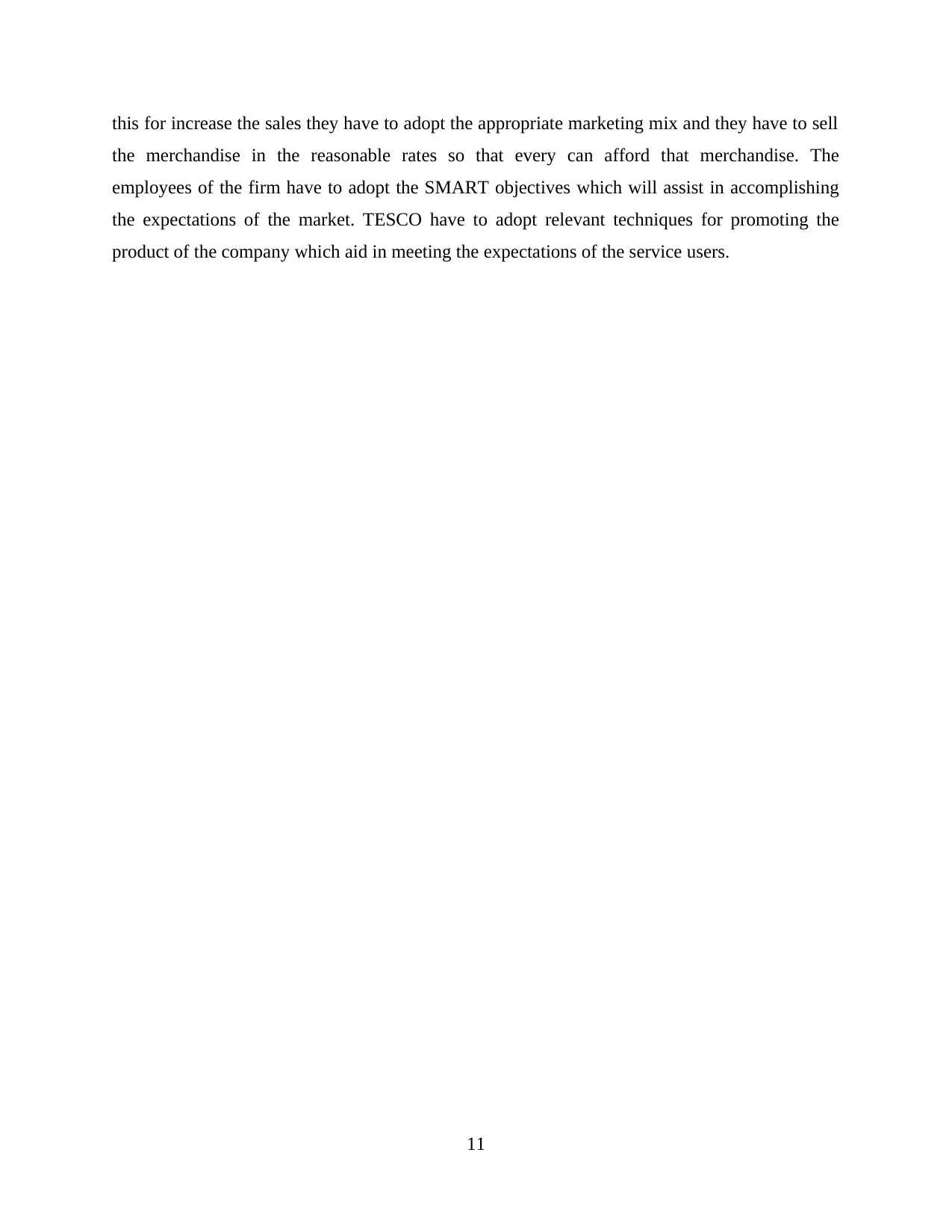
this for increase the sales they have to adopt the appropriate marketing mix and they have to sell
the merchandise in the reasonable rates so that every can afford that merchandise. The
employees of the firm have to adopt the SMART objectives which will assist in accomplishing
the expectations of the market. TESCO have to adopt relevant techniques for promoting the
product of the company which aid in meeting the expectations of the service users.
11
the merchandise in the reasonable rates so that every can afford that merchandise. The
employees of the firm have to adopt the SMART objectives which will assist in accomplishing
the expectations of the market. TESCO have to adopt relevant techniques for promoting the
product of the company which aid in meeting the expectations of the service users.
11
Paraphrase This Document
Need a fresh take? Get an instant paraphrase of this document with our AI Paraphraser
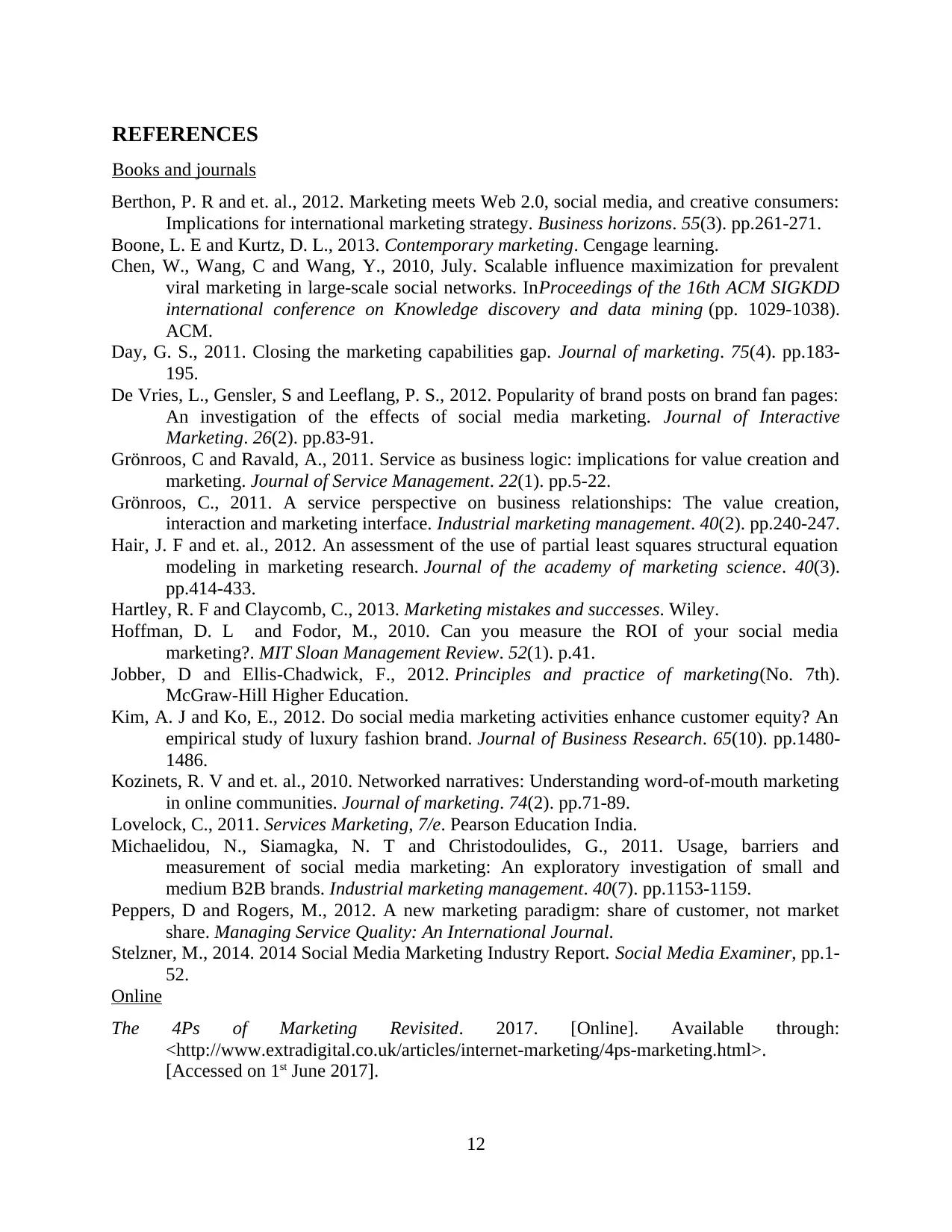
REFERENCES
Books and journals
Berthon, P. R and et. al., 2012. Marketing meets Web 2.0, social media, and creative consumers:
Implications for international marketing strategy. Business horizons. 55(3). pp.261-271.
Boone, L. E and Kurtz, D. L., 2013. Contemporary marketing. Cengage learning.
Chen, W., Wang, C and Wang, Y., 2010, July. Scalable influence maximization for prevalent
viral marketing in large-scale social networks. InProceedings of the 16th ACM SIGKDD
international conference on Knowledge discovery and data mining (pp. 1029-1038).
ACM.
Day, G. S., 2011. Closing the marketing capabilities gap. Journal of marketing. 75(4). pp.183-
195.
De Vries, L., Gensler, S and Leeflang, P. S., 2012. Popularity of brand posts on brand fan pages:
An investigation of the effects of social media marketing. Journal of Interactive
Marketing. 26(2). pp.83-91.
Grönroos, C and Ravald, A., 2011. Service as business logic: implications for value creation and
marketing. Journal of Service Management. 22(1). pp.5-22.
Grönroos, C., 2011. A service perspective on business relationships: The value creation,
interaction and marketing interface. Industrial marketing management. 40(2). pp.240-247.
Hair, J. F and et. al., 2012. An assessment of the use of partial least squares structural equation
modeling in marketing research. Journal of the academy of marketing science. 40(3).
pp.414-433.
Hartley, R. F and Claycomb, C., 2013. Marketing mistakes and successes. Wiley.
Hoffman, D. L and Fodor, M., 2010. Can you measure the ROI of your social media
marketing?. MIT Sloan Management Review. 52(1). p.41.
Jobber, D and Ellis-Chadwick, F., 2012. Principles and practice of marketing(No. 7th).
McGraw-Hill Higher Education.
Kim, A. J and Ko, E., 2012. Do social media marketing activities enhance customer equity? An
empirical study of luxury fashion brand. Journal of Business Research. 65(10). pp.1480-
1486.
Kozinets, R. V and et. al., 2010. Networked narratives: Understanding word-of-mouth marketing
in online communities. Journal of marketing. 74(2). pp.71-89.
Lovelock, C., 2011. Services Marketing, 7/e. Pearson Education India.
Michaelidou, N., Siamagka, N. T and Christodoulides, G., 2011. Usage, barriers and
measurement of social media marketing: An exploratory investigation of small and
medium B2B brands. Industrial marketing management. 40(7). pp.1153-1159.
Peppers, D and Rogers, M., 2012. A new marketing paradigm: share of customer, not market
share. Managing Service Quality: An International Journal.
Stelzner, M., 2014. 2014 Social Media Marketing Industry Report. Social Media Examiner, pp.1-
52.
Online
The 4Ps of Marketing Revisited. 2017. [Online]. Available through:
<http://www.extradigital.co.uk/articles/internet-marketing/4ps-marketing.html>.
[Accessed on 1st June 2017].
12
Books and journals
Berthon, P. R and et. al., 2012. Marketing meets Web 2.0, social media, and creative consumers:
Implications for international marketing strategy. Business horizons. 55(3). pp.261-271.
Boone, L. E and Kurtz, D. L., 2013. Contemporary marketing. Cengage learning.
Chen, W., Wang, C and Wang, Y., 2010, July. Scalable influence maximization for prevalent
viral marketing in large-scale social networks. InProceedings of the 16th ACM SIGKDD
international conference on Knowledge discovery and data mining (pp. 1029-1038).
ACM.
Day, G. S., 2011. Closing the marketing capabilities gap. Journal of marketing. 75(4). pp.183-
195.
De Vries, L., Gensler, S and Leeflang, P. S., 2012. Popularity of brand posts on brand fan pages:
An investigation of the effects of social media marketing. Journal of Interactive
Marketing. 26(2). pp.83-91.
Grönroos, C and Ravald, A., 2011. Service as business logic: implications for value creation and
marketing. Journal of Service Management. 22(1). pp.5-22.
Grönroos, C., 2011. A service perspective on business relationships: The value creation,
interaction and marketing interface. Industrial marketing management. 40(2). pp.240-247.
Hair, J. F and et. al., 2012. An assessment of the use of partial least squares structural equation
modeling in marketing research. Journal of the academy of marketing science. 40(3).
pp.414-433.
Hartley, R. F and Claycomb, C., 2013. Marketing mistakes and successes. Wiley.
Hoffman, D. L and Fodor, M., 2010. Can you measure the ROI of your social media
marketing?. MIT Sloan Management Review. 52(1). p.41.
Jobber, D and Ellis-Chadwick, F., 2012. Principles and practice of marketing(No. 7th).
McGraw-Hill Higher Education.
Kim, A. J and Ko, E., 2012. Do social media marketing activities enhance customer equity? An
empirical study of luxury fashion brand. Journal of Business Research. 65(10). pp.1480-
1486.
Kozinets, R. V and et. al., 2010. Networked narratives: Understanding word-of-mouth marketing
in online communities. Journal of marketing. 74(2). pp.71-89.
Lovelock, C., 2011. Services Marketing, 7/e. Pearson Education India.
Michaelidou, N., Siamagka, N. T and Christodoulides, G., 2011. Usage, barriers and
measurement of social media marketing: An exploratory investigation of small and
medium B2B brands. Industrial marketing management. 40(7). pp.1153-1159.
Peppers, D and Rogers, M., 2012. A new marketing paradigm: share of customer, not market
share. Managing Service Quality: An International Journal.
Stelzner, M., 2014. 2014 Social Media Marketing Industry Report. Social Media Examiner, pp.1-
52.
Online
The 4Ps of Marketing Revisited. 2017. [Online]. Available through:
<http://www.extradigital.co.uk/articles/internet-marketing/4ps-marketing.html>.
[Accessed on 1st June 2017].
12
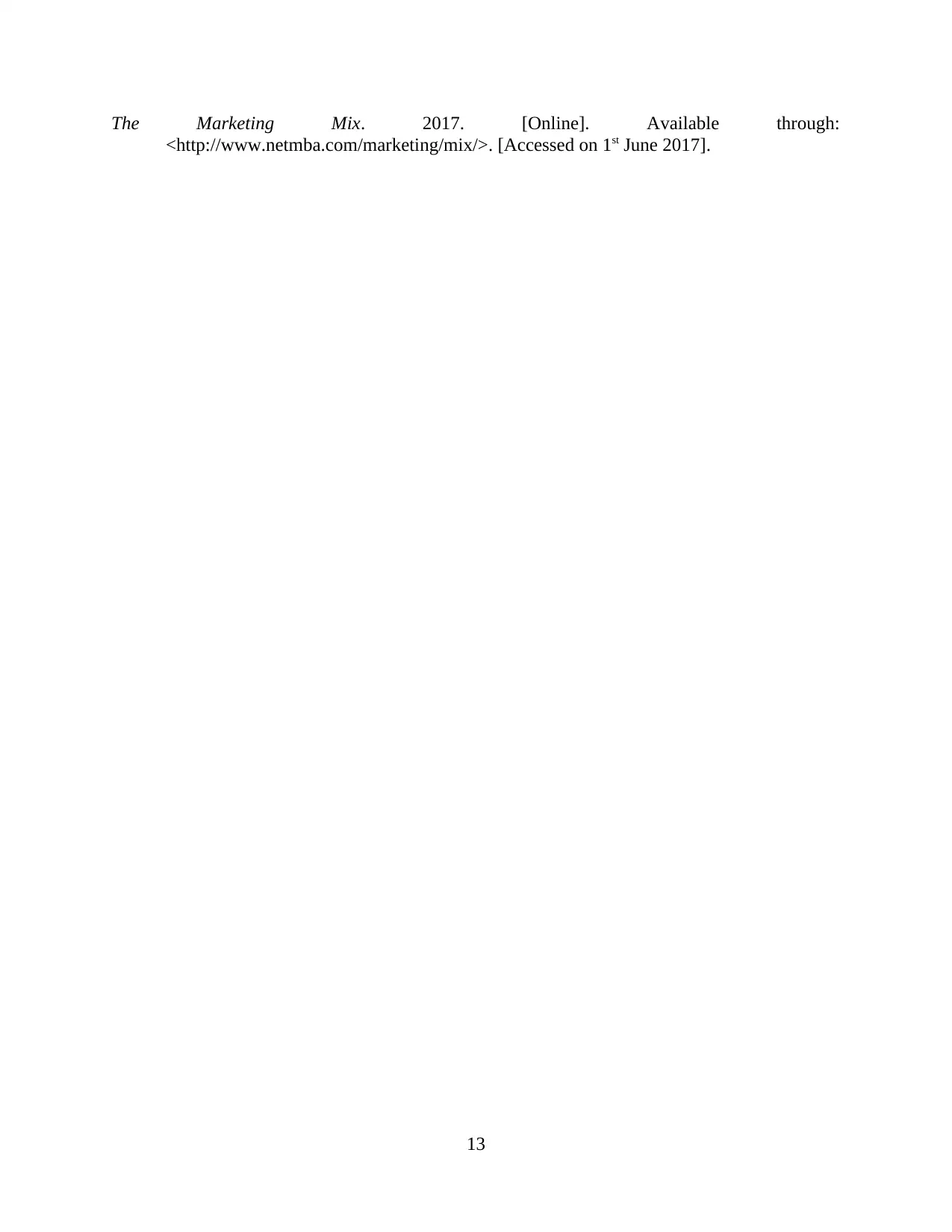
The Marketing Mix. 2017. [Online]. Available through:
<http://www.netmba.com/marketing/mix/>. [Accessed on 1st June 2017].
13
<http://www.netmba.com/marketing/mix/>. [Accessed on 1st June 2017].
13

14
1 out of 16
Related Documents
Your All-in-One AI-Powered Toolkit for Academic Success.
+13062052269
info@desklib.com
Available 24*7 on WhatsApp / Email
![[object Object]](/_next/static/media/star-bottom.7253800d.svg)
Unlock your academic potential
© 2024 | Zucol Services PVT LTD | All rights reserved.





